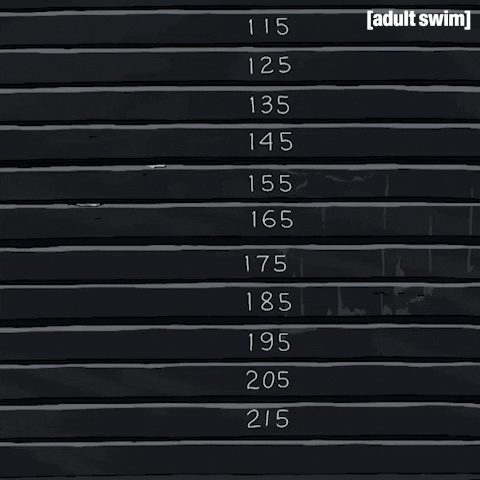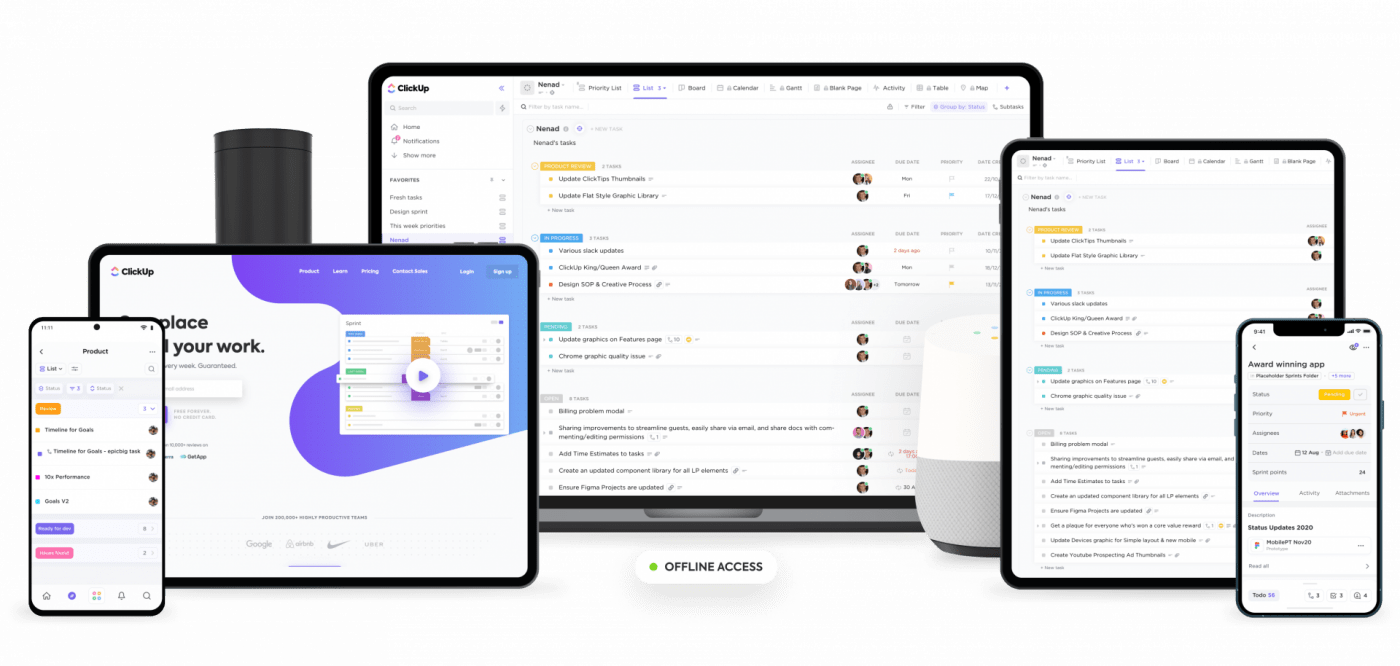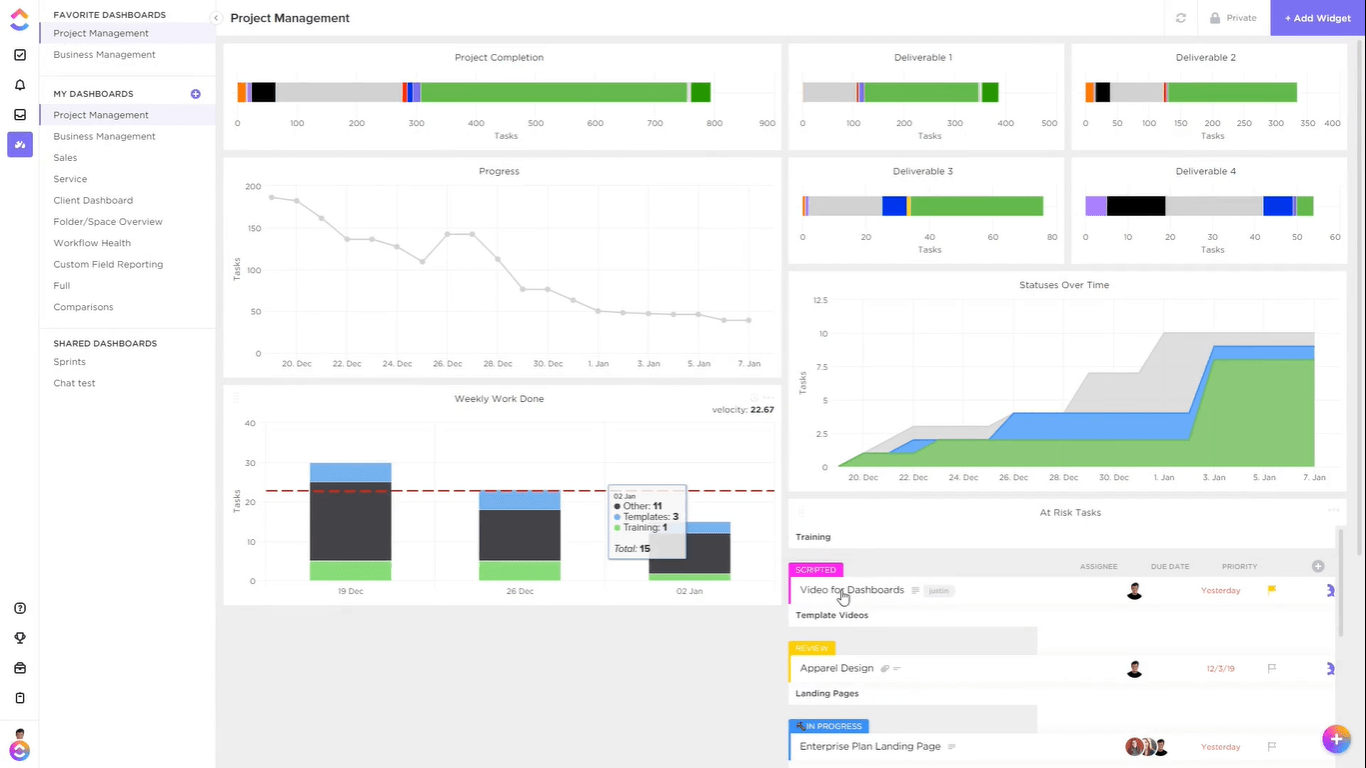

Ready to learn about the project management life cycle?
Project management is a long and complex process that can unnerve even the most experienced management experts!
So to make everyone’s job a little bit easier, the concept of a project life cycle was born.
In this article, we’ll explain what the project life cycle is, highlight each phase of the life cycle, and go over the best project management tool to manage it!
And since the life cycle deals with time and space, we’ll take some help from a few experts to explain this concept.

Say hello to Rick and Morty!
Let’s go!

Don’t worry Morty! It’s going to take you a lot less than twenty minutes to get through this!
What is Project Management?
Project management is the practice of initiating, planning, executing, maintaining, and closing a project to achieve a certain goal.
Here’s an example of a project management plan in action:
Let’s say Rick has a new personal project – gaining muscle so he could beat up aliens!

But how does Rick ensure that he is able to complete the project?
That’s where project management comes in!
Project management processes allow him to:
- Initiate: decide on how to bulk up
- Plan: create a workout routine
- Execute: follow the routine
- Maintain: add more reps to the exercise if necessary
- Close: finish the plan
Similarly, in businesses, projects are operations that are conducted to meet specific goals and objectives. And unlike Rick’s muscle-building program, this project management process consists of project resources, team members, and deadlines.
The product life cycle helps you organize all these resources and activities to ensure that your project is a success!
What is a Project Life Cycle?
Just like the human life cycle spans from birth to death, the project life cycle is the process that needs to be followed to lead a project from start to finish.
Managing an entire project on your own can be really intimidating.
Think about it.
You not only have to manage the work, but also the team, the customer’s expectations, the processes, and the project deliverables.
This might lead you to end up feeling like Rick here!

That’s why it’s important to split the work into small manageable steps.
In the life cycle, work is split into five different phases to make it a lot easier to deal with.
Almost every project manager uses the project management lifecycle to achieve project success – and so should you!
What are the 5 Key Life Cycle Phases?
What are the 5 Key Life Cycle Phases?
The project life cycle is made up of the:
- Initiation phase
- Planning phase
- Execution phase
- Monitoring phase
- Closure phase
Your project has to pass through each stage of this predictive life cycle to be a success. Additionally, each phase generally has a deadline because you don’t want the project to be stuck in one phase forever!
Let’s take a deep dive into each phase:
1. The initiation phase
The first phase of the project life cycle answers the question:
‘Why do we need this project?’
This phase essentially gives your project a purpose.

In this project phase, you need to:
- Identify a business opportunity
- Develop a project idea to tackle that opportunity
So how do you do that?
Here are the steps involved in this phase:
A. Create a business case
A business case is a document that explains why a new project should be started. The ideal business should be clear, logical, relevant, and comprehensive.
Business cases vary from project to project, but they have a common structure:
- Preface
- Table of contents
- Project details
- Analysis of future costs, benefits, and disadvantages
- Conclusion
B. Do a feasibility study
After the business case has been approved, you need to create a document that answers the following two questions:
- Will the proposed project work?
- Should the team proceed with it?
It also helps you outline the risks involved and how you’ll solve them.

C. Create a project charter
Every project needs a project charter – otherwise, the project will lack structure.
And without structure, there will be chaos!

Don’t panic, Rick! Here’s how you can create a project charter:
The project charter includes:
- Vision: what you wish to achieve with the project in the future
- Project scope: work that will be covered within the project
- Project’s objective: desired results of the project
- Deliverables: objectives and measures of success
- Responsibilities of the team: what the team is expected to do
With this document in place, the execution phase will go off without a hitch!
D. Assemble a team
To pull off a successful heist, Rick needed a team with unique skills:

Similarly, in order to tackle a project, you need team members with different skill sets.
Create a doc that lists all the roles for each team member, as well as their responsibilities.
How do you find these team members?
Create an organizational chart that lists:
- Skills required for a job role
- Experience needed for each position
This will help you narrow down your search for your final project team.
Now let’s move on to the next phase.
2. The planning phase
What’s the key to project success?
Planning, planning, and more planning!
A project without a management plan is like a spaceship without brakes!

It’s bound to crash!
The project planning phase is important because it prevents your team from losing control of the project scope, which ultimately leads to scope creep.
Note: Your project scope includes everything that goes into a project. Scope creep is a management term referring to the rapid, uncontrolled growth of scope during a project.
Now, let’s take a look at what goes on during the planning phase:
A. Creating goals and objectives
Before you start planning ahead, you need to ask yourself, ‘What do I want to achieve with this project?’
Do you want to:
- Make customers happy?
- Increase revenue?
- Cut production costs?
For example, Rick’s project goals would be to earn money through his cool inventions.

Now, your project planning needs to figure out how you’re going to achieve that goal.
You need to break that goal down into a few statements called objectives.
For example, Rick’s primary project objective would be to ‘Produce more Portal Guns’ to reach his goal.
B. Writing a scope statement
A project scope statement defines what work will be done and what won’t be done in the project.
Here’s what a project scope statement for developing software would include:
- Product Scope: everything that goes into developing your software
- Deliverables: components of the project like specific software features
- Product Acceptance Criteria: the conditions that need to be met for success
- Risks: issues or constraints that can affect your project
All the stakeholders, including clients and investors, have to agree to the project scope – otherwise, it’s back to the drawing board!
C. Estimating the budget
A study by The Project Management Institute found that around 43% of projects exceed their budget.
That means you have roughly 1 in 2 chances of going over budget, which can lead to:
- Reduced return on investment
- Financial losses
- Possible project failure!
So stop daydreaming while doing the math!

Calculate an estimate of the costs of all the resources, salaries, and tools required to complete the project and try to follow it as carefully as possible.
D. Gathering resources
Once you’ve set the budgets, you need to make sure your team has everything they need to create a successful project.
Which means you need to purchase:
- Necessary equipment like servers, laptops, printers, etc.
- Software licenses
- Project management tools
- Anything else they need for the project!
E. Creating a project timeline
A project timeline lists out all the project tasks that need to be completed sequentially.
Each task must also have a fixed deadline, so your team doesn’t sleep on the job like Morty here!

3. The execution phase
After you’ve gained approval from the stakeholders, created a team, and developed a project plan, it’s time to get to work on the project!

Mr. Meeseeks is ready… Are you ready too?
In the project execution phase (also known as the implementation phase), the project manager has a few key responsibilities like:
- Managing team members
- Following the project timeline
- Communicating important information with all stakeholders
Now let’s take a closer look at project management processes involved in the execution phase:
A. Briefing the project team
Before assigning tasks to your team, it’s important to tell them what they’re getting into.
Here’s what you need to do:
- Explain how a task should be completed
- Create company Docs to explain certain processes
- Conduct training sessions if necessary
And while you’re assigning tasks, don’t assign an excessive amount of work or it’ll affect project performance.
It’ll leave them overwhelmed like Rick and Morty after too many space adventures!

B. Reporting progress
While your team is working on the project plan, a project stakeholder might regularly ask them to:

And how does your project team show them their project progress?
Your team has to share weekly reports of the tasks they’ve completed, and the project deliverables they’ve finished.
C. Managing issues
As work on the project continues, issues are bound to pop up regularly.
Your team can face problems related to time management, budget management, software bugs, team morale, and more.
Here’s how you can manage those issues:
- Create a document to store a list of issues
- Ask your team to log issues to the document
- Assign team members to help fix the problems
- Monitor progress of the issue
- Resolve issues when they’re done
Note: The longer the issue remains unresolved, the more problems it can cause. It’s a good idea to mark tasks related to issue management as a high priority.
D. Holding weekly meetings
At the end of the week, project managers and team members should come together to discuss:
- What they’ve worked on
- The issues that they’ve faced
These meetings ensure that no task slips under the cracks, and the project work is running smoothly.
For example, every morning, Scrum teams host meetings known as daily standups to discuss what they’ll be working on for the day.
4. The monitoring phase
Even though it’s the fourth phase of the project life cycle, the project monitoring phase happens at the same time as the execution phase.
So how is it different?
This phase is all about measuring and tracking your team’s performance over executing the project plan.
It’s going to help managers like Rick say:

Let’s take a look at the three project management processes involved in the project monitoring phase:
A. Choosing KPIs
How do you know if the project is on track?
Through KPIs.
KPIs (key performance indicators) are metrics used to measure the team’s performance over key business activities.
A project manager usually picks a few KPIs like:
- Quality of deliverables: identifies if project deliverables are being produced
- Costs: ensures if the project doesn’t exceed the budget
- Issue resolutions: monitors the issues that arise and how quickly they are fixed
B. Measuring progress
Now that you’ve set the KPIs, you need a way to measure them.
Fortunately, a project management tool can help you with this!
A good project management tool will have dashboards that take in real-time project data (like completed tasks, time tracked, etc.), and track your metrics. Just one glance at these dashboards, and you’ll have a complete picture of what’s going on within the project!
C. Refining processes
The dashboards will also indicate the areas where your project team is crushing their goals and where they’re struggling. Use this to identify bottlenecks in and figure out a way to eliminate them.
5. The closure phase
Because of the time and effort put into the planning stage and execution, most companies rush through the final phase of the project life cycle.
However, this phase is equally important!
There’s still a lot of work that is left to be done after the project is finished.
Here’s what goes on in the project closure phase:
A. Analyze performance
Verify if the project goals and objectives that you had set earlier were met.
You should also evaluate how individual team members performed.
Reports and reviews can indicate whether they met their goals, determine their quality of work, and identify if they met their deadlines.
After analyzing that data, you can (hopefully) tell your project team:

B. Create final documents
You finished your project!
Congratulations.
But you’re not done yet.
When you’re saying goodbye to your stakeholders, you’ll have a lot of paperwork to do!
This includes:
- Closing contracts
- Creating invoices
- Generating reports
After you’ve sent the paperwork to your client, it’s a good idea to create a copy of it and store it in your archives for future reference.
C. Release resources
After the project team has served its purpose, you have to redistribute them to be available for future projects.

And if there are any unused funds (as if!), you can allocate it for the next project.
D. Celebrate success!
After achieving project success, you should acknowledge your team for doing a great job!
Consider rewarding your project team with something after the project closure phase. Not only does it boost team morale, but it also creates loyalty. This way, your project team is motivated to work harder on their future projects.
But for now, it’s time to loosen up. Or as Rick and Morty would say – it’s time to Get Schwifty!

How do you Manage Project Management Processes?
Project management becomes ridiculously easy when you use a software, like ClickUp. And the best management tools have everything you need to manage each life cycle phase.
Fortunately, that’s exactly what ClickUp was built for:
What’s ClickUp?

ClickUp is the world’s highest-rated project management tool that’s used by teams of all types and sizes worldwide. Whether you use Agile, Scrum or any other project methodologies, it has everything you need to manage every phase of your project life cycle.
Let’s take a look at how ClickUp can manage your lifecycle processes:
1. For the initiation phase
Whether you like it or not – the initiation requires a lot of paperwork!
You need to create and store documents like the feasibility study, and the project charter.
ClickUp’s solution: Docs
Docs are a great place to store all your initiation phase documents.
Not only does it allow you to create well-formatted documents, but also Docs helps you collaborate remotely in real-time!

And that’s not the best part!
ClickUp allows you to gather and store all your scattered project documents in one place for better accessibility.
So if you have company docs on Evernote, Notion, & Google Docs – you can import them faster than Rick can say his catchphrase:

2. For the planning phase
You’ve set a few goals and objectives for your project. But those goals are useless if there’s no easy way to carefully plan them out!
Don’t worry, ClickUp’s got you covered:
ClickUp’s solution: Goals
In ClickUp, Goals are high-level containers that can be broken down into smaller objectives known as Targets.
Just create your project Goal and then set measurable Targets to achieve them!
For example:
Rick’s project Goal was to – ‘Earn money through inventions’.
He then would have two measurable Targets for his project team:
- Create 50 portal guns
- Produce 20 Interdimensional cable TV boxes

As he progresses, he can update his targets in ClickUp.
And here’s where the magic happens…
ClickUp automatically calculates your project goal progress in real-time!
This can motivate him to keep pushing forward until their goal.
Note: If you’re using the Agile project management methodology, you can use the Goals feature to create sprint goals to track the progress of the sprint.
3. For the execution phase
If project management was a movie – then the project execution phase would be the fast-paced action sequence!

You need to assign tasks, manage workflow and teams – all under a tight deadline!
Additionally, maintaining proper communication is absolutely crucial during the project execution phase. Even the most planned projects can derail due to miscommunication!
Here’s how ClickUp helps you navigate the execution phase:
ClickUp’s solutions
A. Assign Tasks
Assigning project tasks in ClickUp is as easy as summoning Mr. Meeseeks!

Just create a new task and add all the project team members that need to work on it. Your team members get instantly notified of this and can begin work on it!

B. Track time taken on tasks
Want your team to pick up the pace?
You can add a time estimate to each task to give your team an idea of how long they have to complete it.

To ensure that your team is sticking to the project schedule, each team member can track the time spent on each task with ClickUp’s Chrome extension.

Already using a time tracker?
No problem!
ClickUp integrates with loads of time tracking tools, including Toggl, Everhour, Time Doctor, and more. This way, your team stays productive – even when they’re working remotely!
C. Comments
Since you don’t have a lot of time on your hands – you need a quick and efficient way to communicate with your team.
That’s why each task has in ClickUp has a comment section, which your team can use for:
- Clearing up any doubts
- Alerting the team about the issues they’ve faced
- Sending documents related to the task
You can even assign tasks to your team members with the Assigned Comments feature.
With an Assigned comment, you can instantly convert a comment into a task, and then assign it to your team members, so they take action on it immediately!

4. For the monitoring phase
During the project monitoring phase, you’re going to have to track your project progress.

Yup – even Rick needs some monitoring help to run a successful project!
Here’s how ClickUp can help you:
ClickUp’s solution – Dashboards
ClickUp’s Dashboard has plenty of Widgets that cover your project’s progress:
- Burn-Up Charts: determines how close your team is to finish the entire project
- Burndown Charts: visualizes the amount of work remaining in a project
- Velocity Charts: determines the number of tasks your team can complete in a given period of time

Note: These widgets work best when you’re using Scrum and Agile project management techniques.
5. For the closure phase
Just like the initiation phase, the project closure phase also requires a lot of paperwork!

Don’t worry, it’s much easier this time around!
With project management software like ClickUp, you can instantly generate and share reports for detailed insights on how things went.
ClickUp’s solution – Team Reports
Task Completed Report
This report displays the number of tasks completed by each team member.

Worked On Report
This report displays the number of tasks each team member has been a part of.

Time Tracked Report
This report measures the amount of time your team spent on the project tasks.

Worried that these reports will fall into the wrong hands?
ClickUp allows you to customize the permissions to your reports, to ensure that only specific stakeholders can access them.
Conclusion
The project lifecycle organizes your project work into manageable chunks – to make attempting it easier for your project team.
But simply defining your project life cycle isn’t enough.
You’ll also need a project management tool to guide every step of the way.
Luckily, that’s exactly what ClickUp was made for.
It’s going to be the Morty to your Rick – helping you navigate each phase of your project management life cycle with ease!

So sign up for ClickUp, and ensure that project life processes remain as smooth as the sounds of Snake Jazz!


Questions? Comments? Visit our Help Center for support.